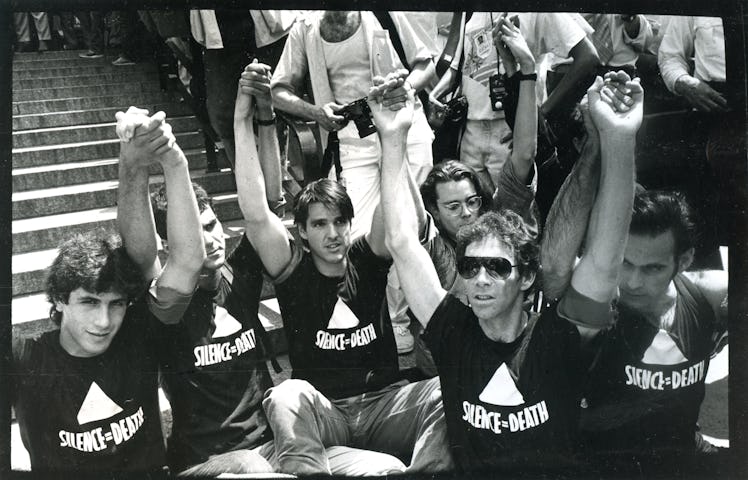Few graphics are as instantly recognizable as the “Silence=Death” poster created in 1986 by the American artist Avram Finkelstein and the Silence=Death Collective. The piece was designed as an urgent response to the AIDS epidemic and ensuing political fallout of the time—yet, amid the current social and political realities of the world, along with continued efforts for equal rights of the LGBTQ+ community and the approximately 38 million people worldwide still living with HIV, those simple yet piercing words feel especially necessary now. Speaking at NADA New York in early May with executive director of the NYC AIDS Memorial organization Dave Harper, Finkelstein recalled the conception of the poster and its subsequent meaning almost 40 years later.
“Shortly after the man I was building my life around, Don Yowell, died of AIDS in 1984, I formed a consciousness-raising collective with five of my friends to help me through it,” Finkelestein said. The group, which also included Brian Howard, Oliver Johnston, Charles Kreloff, Chris Lione, and Jorge Soccarás, found themselves talking more and more about the political crisis they saw forming—and the lack of public discourse around it. Following the tradition of wheat-pasting that thrived in New York City at that time, Finkelstein suggested they make a poster as a way to ignite the conversation.
The collective spent nine months deliberating and considering each element of the poster. They wanted it to be critical and welcoming, specific and adaptive. They intentionally chose to use advertisement-like language, because as Finkelstein put it, “advertisement, in my estimation, has become the folk language of capitalism.”
The final product, which displayed the words “Silence=Death” combined with an upward-facing pink triangle floating above it, were meant to appear cryptic from a distance—yet still attract those passing by it to take a closer look, read the small type, and, ultimately, take action.
The choice to use a pictographic symbol over the representation of a human figure was deliberate. The pink triangle has historical roots in the Holocaust; prisoners in concentration camps accused of being gay by the Nazis were forced to wear a pink triangle on their uniforms. The shape was then used in the ’70s by gay rights activists in the U.S., and even appeared in the 1979 play Bent by Martin Sherman, whose subject matter centered the Third Reich’s prosecution of the LGBTQ+ community. “One of the members of the collective had recently been to Dachau [in Germany] and believed that the pink triangle was pointing up,” Finkelstein explained during his speech at NADA. “The person who laid out the poster said he would research it, and didn’t. In fact, in the camps, the triangle pointed downward.” The collective had the opportunity to correct the mistake after the first round of printing, but instead decided to embrace the departure from its original source and the victimhood brought by its ties to the Holocaust.
Silence=Death poster. Courtesy of artist.
Their decision culminated in one of the most impactful visual messages of our time. Within weeks of wheat-pasting the Silence=Death poster on the streets of New York, they were surrounded by a community that went on to form the AIDS activist group ACT UP. Photojournalist Donna Binder, who shot many of their protests, remembers being present at the first meeting for ACT UP. “This was really important. It was dire, people were dying. It was a desperate movement because it was a race against time," Binder told W in a recent interview. “And I think the amazing people that came together to form ACT UP came with so many different expertise and talents. ACT UP was really great at distilling a message into something that could be either seen visually quickly or into sound bites.”
The poster is still used by ACT UP today, and has become synonymous with the LGBTQ+ rights movement. It was part of an exhibition at David Zwirner last year titled “More Life” that included a limited-edition print sale of the poster.
The placement of “Silence=Death” in the public domain has led to its usage for a multitude of situations far beyond its original purpose. “Its continuously evolving social context underscores how carefully crafted images may be utilized to open portals through which evolving social dynamics can maneuver between history, political resistance, and commerce without sacrificing the ability to represent the efficacy of cultural production during moments of social injustice,” Finkelstein said.
And yet, among the Pride messaging this month (and the many seemingly insincere attempts by corporations to capitalize on the movement), it is important to remember the tragedy the poster was created to represent. The AIDS epidemic is still not over, and the fight for LGBTQ+ rights marches on.
